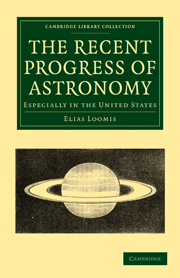Book contents
- Frontmatter
- PREFACE
- Contents
- CHAPTER I RECENT ADDITIONS TO OUR KNOWLEDGE OF THE PLANETARY SYSTEM
- SECTION I
- SECTION II
- SECTION III
- SECTION IV
- SECTION V
- CHAPTER II RECENT ADDITIONS TO OUR KNOWLEDGE OF COMETS
- CHAPTER III ADDITIONS TO OUR KNOWLEDGE OF FIXED STARS AND NEBULÆ
- CHAPTER IV PROGRESS OF ASTRONOMY IN THE UNITED STATES
- POSTSCRIPT
- Frontmatter
- PREFACE
- Contents
- CHAPTER I RECENT ADDITIONS TO OUR KNOWLEDGE OF THE PLANETARY SYSTEM
- SECTION I
- SECTION II
- SECTION III
- SECTION IV
- SECTION V
- CHAPTER II RECENT ADDITIONS TO OUR KNOWLEDGE OF COMETS
- CHAPTER III ADDITIONS TO OUR KNOWLEDGE OF FIXED STARS AND NEBULÆ
- CHAPTER IV PROGRESS OF ASTRONOMY IN THE UNITED STATES
- POSTSCRIPT
Summary
Seventy-five years since, the only planets known to men of science were the same which were known to the Chaldean shepherds thousands of years ago. Between the orbit of Mars and that of Jupiter, there occurs an interval of no less than 350 millions of miles, in which no planet was known to exist before the commencement of the present century. Nearly three centuries ago, Kepler had pointed out something like a regular progression in the distances of the planets as far as Mars, which was broken in the case of Jupiter: Having despaired of reconciling the actual state of the planetary system with any theory he could form respecting it, he hazarded the conjecture that a planet really existed between the orbits of Mars and Jupiter, and that its smallness alone prevented it from being visible to astronomers. The remarkable passage containing this conjecture is found in his Prodromus, and is as follows: “When this plan, therefore, failed, I tried to reach my aim in another way, of, I must confess, singular boldness. Between Jupiter and Mars I interposed a new planet, and another also between Venus and Mercury, both which it is possible are not visible on account of their minuteness, and I assigned to them their respective periods. In this way I thought that I might in some degree equalize their ratios, which ratios regularly diminished toward the sun, and enlarged toward the fixed stars.”
But Kepler himself soon rejected this idea as improbable, and it does not appear to have received any favor from the astronomers of that time.
- Type
- Chapter
- Information
- The Recent Progress of AstronomyEspecially in the United States, pp. 54 - 95Publisher: Cambridge University PressPrint publication year: 2010First published in: 1856



